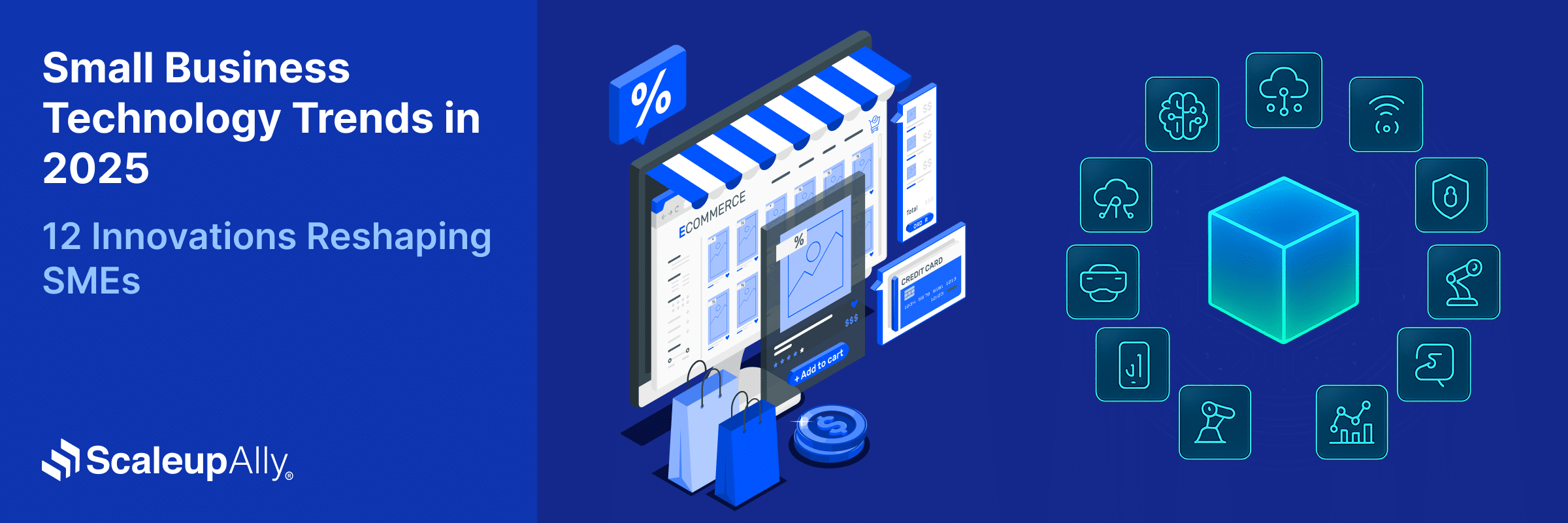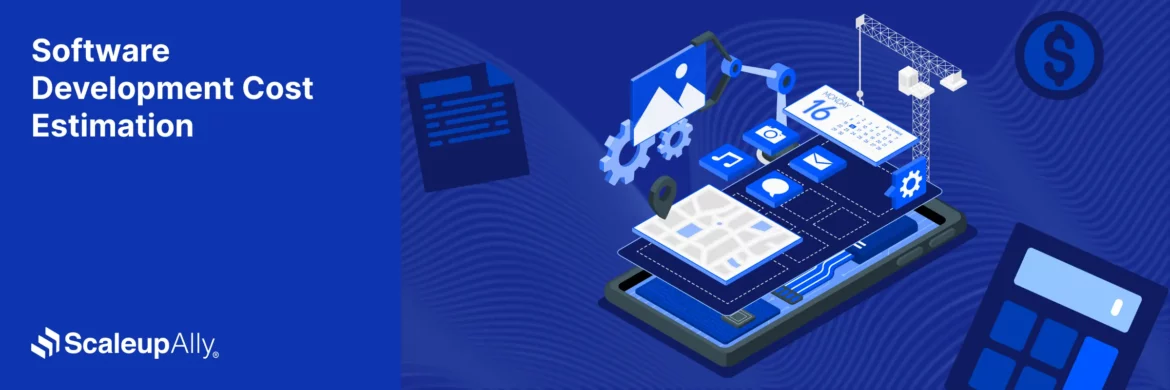
Small Business Technology Trends in 2025: 12 Innovations Reshaping SMEs
Suprabhat Sen | September 29, 2025 , 11 min read
Table Of Content
It is no secret how hard it is to run a small business. You have rising costs to deal with, staffing challenges, and customers who expect Amazon-level service from your three-person team. These challenges are enough to make anyone want to hide under their desk.
Challenging as it can be, technology can be a leveler between small businesses and Fortune 500 companies. We asked experts about their thoughts on technology trends in small businesses for 2025, and we are sharing the results with you in this blog. Read on to learn how these small business technology trends can make your small business more competitive starting this year and in the years to come.
Key Takeaways
- With 43% of cyberattacks targeting small businesses and 60% closing within 6 months of an attack, plus rising customer expectations for enterprise-level service, technology has become critical infrastructure rather than a nice-to-have.
- 94% of professionals prefer centralized platforms over disconnected tools. The winning strategy is choosing technologies that work together (CRM + accounting + marketing automation) rather than the best individual tools that don’t integrate.
- Companies see $8.71 return for every $1 spent on CRM, $36-40 return on email marketing automation, and 25-30% productivity gains from workflow automation, with most businesses achieving ROI within 12 months.
- With 75% of enterprises adopting cloud backup by 2025 and managed services growing 13.5% annually, small businesses are accessing enterprise-grade capabilities through affordable monthly subscriptions rather than expensive infrastructure investments.
- Windows 10 support ends October 2025, 5G is becoming critical for AI operations, and businesses that don’t modernize risk being left behind as technology becomes the primary competitive weapon in an increasingly digital marketplace.
12 Key Small Business Technology Trends in 2025
Our research indicates that Artificial Intelligence (AI) in small businesses, business automation and workflow tools, and data analytics for small businesses are being adopted extensively across small businesses to gain a competitive edge. Let’s explore these small business technology trends in detail.
1. AI will gain wider adoption
Since the introduction of ChatGPT in 2022, AI has changed the trajectory of businesses of all sizes. For example, the BKW Group created Edision, an AI-supported platform developed to securely and effectively tap into internal data, enabling staff to analyze internal information in context, to generate content, and to handle recurrent tasks more efficiently. Employees using Edision were able to process media queries 50% faster, and more than 40 other use cases were documented.
AI has moved beyond talk. It is a tool to help small businesses like yours get more done faster with little effort. Practical use cases of AI include crafting marketing emails, generating blog posts, and attending to customer support using AI-powered chatbots.
In a study by Salesforce, they found that 91% of SMBs using AI report a boost in revenue, and growing businesses are nearly twice as likely to invest in AI compared to those in decline.
Meanwhile, NVIDIA found AI deployments in retail stores caught 98% of instances of theft, fraud or human error, which led to a quick return on investment. AI can do more for you as a small business.
2. The use of cloud accounting software
Running a business involves managing finances carefully, and accounting software makes that process much easier while remaining financially attractive. Businesses using accounting and automation software report up to 20% productivity improvements.
The cost of accounting software is usually tax-deductible as a business expense, and many options are surprisingly affordable. For example, Zoho Books offers free plans for businesses with under $50K in revenue, while other platforms start at just $15-20 monthly. For the seamless flow of data across business operations, most accounting tools integrate with CRM systems, e-commerce platforms, payroll software, and tax preparation tools.
3. Adoption of affordable CRM systems
CRM is one of the highest-ROI business investments available. Companies that invest in CRM see an average return of $8.71 for every $1 spent. CRM applications can help increase sales by up to 29%, sales productivity by up to 34%, and sales forecast accuracy by 42%. As a small business, this is a huge transformation.
CRM applications shouldn’t be looked at as luxury software for small businesses; they are a necessity. 65% of companies using mobile CRM are achieving their sales quotas, compared to only 22% that don’t use mobile CRM.
4. Cloud-based productivity suites
Google Workspace owns the global office software market share of 44%, while Microsoft 365 holds 30%. This distribution represents a competitive landscape where both platforms serve distinct business needs. Over 3.7 million companies globally use Microsoft 365, while most Microsoft 365 customers are small to mid-sized businesses with fewer than 50 employees.
Google Workspace is an attractive option for personal use and for small businesses that need inexpensive tools with real-time collaboration. However, the choice between platforms matters less than simply adopting one of them; cloud-based office software is no longer optional.
5. Multiplying revenue with automated marketing tools
On average, companies make $5.44 for every $1 they spend on marketing automation. Email marketing delivers an even higher average ROI of $36-$40 for every dollar spent. Currently, only 45% of small businesses use marketing automation tools. This leaves significant room for growth among the remaining 55%.
Data shows that marketing automation transforms small businesses into proactive revenue generators. The right tools will enable personalized, timely customer engagement for a competitive advantage.
6. Cybersecurity Solutions
43% of cyber-attacks target small businesses, with only 14% of SMBs prepared to face such attacks. The financial impact is devastating: small businesses can expect to pay $120,000 to $1.24M in 2025 to respond and resolve a security incident, while 60% of small businesses that suffer a cyberattack shut down within six months.
With cyberattacks targeting nearly half of all small businesses and causing business closure rates of 60%, cybersecurity isn’t optional; it’s survival insurance. The cost of prevention pales compared to the average $120,000+ recovery expense and potential business extinction.
7. Cloud Storage and Backup
The global cloud backup market was valued at $4.69 billion in 2023. It is also expected to grow at a rate of 24.4% from 2024 to 2030. More on that, Gartner predicts that by 2025, over 75% of enterprises will adopt cloud backup solutions. Small & Medium Enterprises (SMEs) are the major end-users; they represent 69.5% of the market in 2025. Cloud storage has evolved from a trendy option to essential infrastructure. It will transform your business data from a potential liability into a protected, accessible asset.
8. 5G-Enabled Business Operations
88% of U.S. businesses consider 5G “critical to optimizing the use of AI in the workplace”, while 87% of industrial enterprises adopting private wireless and on-premise edge saw ROI within one year. The global 5G mobile subscriptions reached 2.3 billion at the end of 2023, with North America forecasted to have 90% of mobile connections on 5G by 2030.
5G is the foundation for IoT, AI, and automated operations that transform small businesses from reactive to predictive, data-driven enterprises.
9. Workflow Automation Tools
80% of organizations will adopt intelligent automation by 2025, with over 80% of organizations already planning to increase their investment in automation solutions. 60% of organizations achieve ROI within 12 months of implementation, with average productivity increases of 25-30% in automated processes.
With 80% of organizations adopting intelligent automation by 2025 and businesses saving $46,000 annually while achieving 25-30% productivity gains, workflow automation is a survival in a market where 75% view it as a competitive necessity.
10. Managed IT Services
The managed services market size started at $278.9 billion in 2022 and is projected to reach $834.7 billion by 2032, while the global managed services market exceeded $341.08 billion in 2024 and is projected to expand at a CAGR of more than 13.5%, crossing $1.77 trillion by 2037. 87.5% of small and medium businesses either use managed IT services or are considering them.
With the managed services market growing at 13.5% CAGR and 87.5% of SMBs adopting or considering these services, managed IT is strategic transformation that delivers 99.99% uptime, 65% budget optimization, and 53% growth acceleration while freeing businesses to focus on core competencies rather than technical complexities.
11. Integrated Business Platforms
Integrated business platforms represent the convergence of multiple business tools into unified ecosystems. Too many small business owners get caught stacking random tech tools without integration. The focus is shifting toward collaborative tools that connect with existing systems; CRM connecting with marketing tools, financial platforms, and project management software.
94% of professionals prefer centralized platforms, and businesses achieving 25-30% productivity gains through integration, the era of disconnected tools is ending.
12. Windows 11 Migration and IT Modernization
Windows 11’s market share reached 42.66% with predictions that it will surpass Windows 10 in the coming months, up from 26.19% just 12 months ago. Windows 11 usage in corporations has reached 50.6%, officially passing the halfway mark with a sharp increase of 16.8% since the beginning of 2025, driven by the urgent Windows 10 end-of-support deadline on October 14, 2025.
Only 40% of business devices are ready for Windows 11, and the October 2025 deadline is creating a 14-month maximum planning window. Windows 11 migration isn’t optional; it’s urgent. The choice is between proactive modernization with enhanced AI capabilities and security, or expensive Extended Security Updates that can cost $427 per device over three years while leaving businesses vulnerable and technologically obsolete.
Future Outlook: What’s Next for Small Business Technology?
With technology, what’s hot today might not be tomorrow. Factors such as economic conditions, availability of talent, and effectiveness of how users adopt new technology all play a role in determining what takes off and what doesn’t.
That said, the technologies we’re seeing gain traction now have some staying power. They’re being adopted more widely, they’re generating revenue for the companies using them, and people seem to be genuinely interested in them. So chances are good they’ll keep growing this year and beyond.
Enterprise organizations usually lead the charge with new tech since they have the resources to experiment and take risks. But once these technologies prove themselves and become more common, they get cheaper and easier for smaller businesses to use too, just like how smartphones started as expensive, but eventually everyone has one now.
The future of small business technology isn’t about keeping up with trends, but building an integrated, intelligent, secure technology foundation that enables businesses to compete with enterprises while maintaining the agility that makes small businesses powerful. The companies that thrive will be those that view technology not as a cost center, but as their primary competitive weapon in an increasingly digital world.
Conclusion
Technology is defining who survives and who thrives. From AI automation to cloud integration, these 12 small business technology trends represent your roadmap to competing with enterprises while maintaining small business agility.
Ready to modernize your business technology? Contact us today to discuss how these trends can transform your operations.
Frequently Asked Questions
Q: How can small businesses benefit from AI?
AI helps small businesses automate repetitive tasks, improve customer service with chatbots, and generate marketing content faster. Studies show 91% of SMBs using AI report revenue boosts, with practical applications including email drafting, customer support, and fraud detection, delivering quick ROI.
Q: Which cloud tools are best for SMEs?
Essential cloud tools include Google Workspace or Microsoft 365 for productivity, affordable CRM systems like HubSpot or Pipedrive, cloud accounting software like Zoho Books or QuickBooks, and automated marketing platforms. Choose integrated solutions that work together rather than isolated tools.
Q: What are the biggest technology challenges for small businesses?
The main challenges include cybersecurity threats (43% of attacks target SMBs), integration complexity with disconnected tools, limited IT expertise, and tight budgets. However, cloud-based solutions and managed services now make enterprise-grade technology accessible and affordable for small businesses.
Related Blogs

Top 20 Emerging Technologies of 2026
Discover the top 20 emerging technologies of 2026. Explore which innovations are driving change across healthcare, finance, manufacturing, and other crucial industries.
ScaleupAlly Team
Dec 16 ,
9 min read

Software Development Timeline: Phases, Duration & Estimation Guide
Understand the software development timeline with phase durations, key factors, hidden delays, and practical methods to estimate project time.
Suprabhat Sen
Nov 29 ,
16 min read

Software Development Cost Estimation Guide: What’s Included & What Affects the Price
Explore software development cost components, major pricing factors, and practical estimation methods to plan your project accurately from start to finish.
Suprabhat Sen
Nov 29 ,
14 min read


